Allspice Tree, Pimento
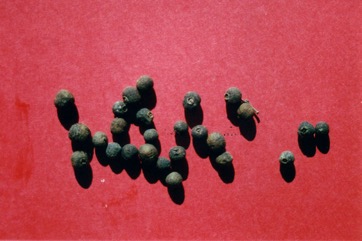
A tropical plant. It is native to tropical America. It suits humid, lowland woodland and savannah. It can tolerate heat and drought. Mature trees can withstand light frost. It is often on well-drained limestone soils up to 1,000 m above sea level. It suits hardiness zones 10-12.
Also known as:
Baharat, Bahar halu, Clove pepper, Jamaican pepper, Myrtle pepper, Piment, Pimienta de Jamaica, Pohon lada jamaica, Poivre de la jamaique
Synonyms
- Caryophyllus pimento Mill.
- Eugenia micrantha Bertol.
- Eugenia pimenta (L.) DC.
- Myrtus dioica L.
- Pimenta officinalis Lindl.
- and others
Edible Portion
- Fruit, Seeds, Leaves, Spice, Herb, Leaves - tea
Where does Allspice Tree grow?
Found in: Africa, Antilles, Asia, Australia, Belize, Bermuda, Brazil, Caribbean, Central America, Cook Islands, Costa Rica, Cuba, Dominican Republic, East Africa, East Timor, El Salvador, Ethiopia, Fiji, Georgia, Ghana, Guatemala, Haiti, Hawaii, Honduras, India, Indonesia, Jamaica, Marquesas, Mexico, Nauru, Nicaragua, North America, Pacific, Pohnpei, Puerto Rico, Reunion, SE Asia, South America, Sri Lanka, Suriname, Timor-Leste, United States, Venezuela, West Africa, West Indies
Notes: There are about 15 Pimenta species. They grow in tropical America.
Status: It is cultivated as a commercial crop.
Growing Allspice Tree, Pimento
Cultivation: Plants are mostly grown from seed. Seed loose their viability quickly. It can also be grown by grafting.
Edible Uses: The dry seeds are used to flavour food. The unripe fruit are dried quickly to produce allspice. The fruit contain an oil used in flavouring. It is used to flavour meat dishes, pickles, sauces, and stuffings. It can be used in vegetable dishes. The leaves can be used as a condiment. They can also be used for tea.
Production: The tree takes 20 year to beging fruiting. The small twigs carrying the berries are cut with clippers. These are dried and cured. They are dried to 10-12% moisture to protect against mould. The red berries are sun dried and become brown. The berry is 3-6 mm across.
Nutrition Info
per 100g edible portion| Edible Part | Energy (kcal) | Protein (g) | Iron (mg) | Vitamin A (ug) | Vitamin c (mg) | Zinc (mg) | % Water |
|---|---|---|---|---|---|---|---|
| Seed | 263 | 6.1 | 7.1 | 54 | 39.2 | 1 | 8.5 |
Allspice Tree, Pimento Photos

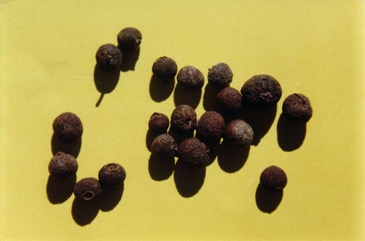
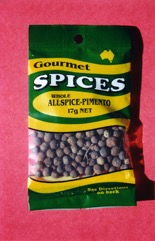
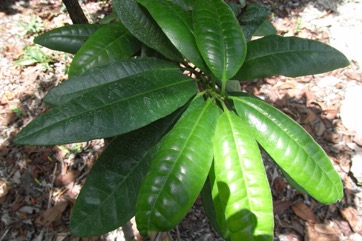
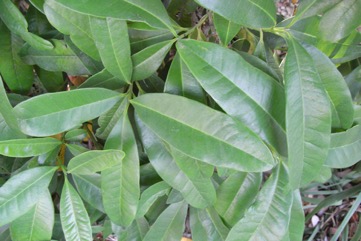
References
Ambasta, S.P. (Ed.), 2000, The Useful Plants of India. CSIR India. p 456
Barwick, M., 2004, Tropical and Subtropical Trees. A Worldwide Encyclopedic Guide. Thames and Hudson p 322
Bodkin, F., 1991, Encyclopedia Botanica. Cornstalk publishing, p 798
Bremness, L., 1994, Herbs. Collins Eyewitness Handbooks. Harper Collins. p 74
Burkill, H. M., 1985, The useful plants of west tropical Africa, Vol. 4. Kew.
Burkill, I.H., 1966, A Dictionary of the Economic Products of the Malay Peninsula. Ministry of Agriculture and Cooperatives, Kuala Lumpur, Malaysia. Vol 2 (I-Z) p 1757 (As Pimenta officinalis)
Cobley, L.S. (rev. Steele, W.M.) 2nd Ed., 1976, An Introduction to the Botany of Tropical Crops. Longmans. p 243
Contr. Gray Herb. 165:37. 1947
Esperanca, M. J., 1988. Surviving in the wild. A glance at the wild plants and their uses. Vol. 1. p 32
Facciola, S., 1998, Cornucopia 2: a Source Book of Edible Plants. Kampong Publications, p 159
Flowerdew, B., 2000, Complete Fruit Book. Kyle Cathie Ltd., London. p 163
Grandtner, M. M., 2008, World Dictionary of Trees. Wood and Forest Science Department. Laval University, Quebec, Qc Canada. (Internet database http://www.wdt.qc.ca)
Hedrick, U.P., 1919, (Ed.), Sturtevant's edible plants of the world. p 495 (As Pimenta officinalis)
Hermandez Bermejo, J.E., and Leon, J. (Eds.), 1994, Neglected Crops. 1492 from a different perspective. FAO Plant Production and Protection Series No 26. FAO, Rome. p 12
Hibbert, M., 2002, The Aussie Plant Finder 2002, Florilegium. p 233
Ibarra-Manriquez, G., et al, 1997, Useful Plants of the Los Tuxtlas Rain Forest (Veracruz, Mexico): Considerations of their Market Potential. Economic Botany, Vol. 51, No. 4, pp. 362-376
Kiple, K.F. & Ornelas, K.C., (eds), 2000, The Cambridge World History of Food. CUP p 1716
Kybal, J., 1980, Herbs and Spices, A Hamlyn Colour Guide, Hamlyn Sydney p 150
Llamas, K.A., 2003, Tropical Flowering Plants. Timber Press. p 289
Macmillan, H.F. (Revised Barlow, H.S., et al), 1991, Tropical Planting and Gardening. Sixth edition. Malayan Nature Society. Kuala Lumpur. p 373
Martin, F.W. & Ruberte, R.M., 1979, Edible Leaves of the Tropics. Antillian College Press, Mayaguez, Puerto Rico. p 207
Menninger, E.A., 1977, Edible Nuts of the World. Horticultural Books. Florida p 83
Miguel, E., et al, 1989, A checklist of the cultivated plants of Cuba. Kulturpflanze 37. 1989, 211-357
Molla, A., Ethiopian Plant Names. http://www.ethiopic.com/aplants.htm
Mulherin, J., 1994, Spices and natural flavourings. Tiger Books, London. p 24
Purseglove, J.W., 1968, Tropical Crops Dicotyledons, Longmans. p 409
Raghavan, S., 2007, Handbook of Spices, Seasonings, and Flavourings. Second Edition. CRC Press p 64
Smith, P.M., 1979, Pimento, in Simmonds, N.W., (ed), Crop Plant Evolution. Longmans. London. p 317
Staples, G.W. and Herbst, D.R., 2005, A tropical Garden Flora. Bishop Museum Press, Honolulu, Hawaii. p 427 (Drawing)
Sukarya, D. G., (Ed.) 2013, 3,500 Plant Species of the Botanic Gardens of Indonesia. LIPI p 448
Tyagi, R. K., et al, 2004, Conservation of Spices Germplasm in India. Indian J. Plant Genet. Resour. 17(3): 163-174
van Wyk, B., 2005, Food Plants of the World. An illustrated guide. Timber press. p 295
Williams, C.N., Chew, W.Y., and Rajaratnam, J.A., 1989, Tree and Field Crops of the Wetter Regions of the Tropics. Longman, p 222
World Checklist of Useful Plant Species 2020. Royal Botanic Gardens, Kew